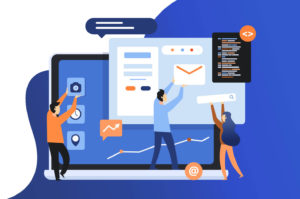Many websites are not designed with accessibility in mind, making it difficult for people with disabilities to use them. As a result, web designers and developers need to prioritize accessibility when building websites.
The internet has become an integral part of our lives, and everyone must have equal access to it. Unfortunately, many websites are not designed with accessibility in mind, making it difficult for people with disabilities to use them. As a result, web designers and developers need to prioritize accessibility when building websites.

In this blog post, we’ll explore some tips for designing accessible websites to ensure that everyone can use them.
-
Use Appropriate Color Contrast for Accessibility
One of the essential things to keep in mind when designing for accessibility is ensuring adequate color contrast. People with visual impairments can struggle to read the text if the color contrast is not high enough. Therefore, it’s crucial to use appropriate color contrast to make text easy to read.
-
Create Text Alternatives for Images
For visually impaired users, images are useless without text alternatives. It’s essential to provide text descriptions of images to ensure that everyone can understand the content on your website. Additionally, including text alternatives can improve your website’s SEO.
-
Use Descriptive Link Text for Accessibility
Using descriptive link text is an important aspect of accessibility. Blind users use screen readers to navigate websites, and descriptive link text helps them understand where the link will take them. Avoid using generic link text like “click here” and instead use descriptive phrases like “Learn more about our services.”
-
Ensure Keyboard Accessibility
Not all users can use a mouse to navigate websites. Therefore, it’s essential to ensure that your website is entirely navigable using only a keyboard. This means that all interactive elements should be reachable via the “tab” key and other shortcuts. Additionally, it’s essential to avoid using mouse-based events, like hover, which can be difficult to use for people with motor impairments.
-
Make Your Website Easy to Navigate
Navigation is a critical aspect of website design. For people with disabilities, it’s even more important that websites are easy to navigate. A clear and consistent navigation structure can make it easier for users to understand the content and find what they need.
-
Use Appropriate Headings for Accessibility
Headings play a critical role in making content accessible. Screen readers use headings to navigate content, and using appropriate headings helps users understand the structure of the content. Use H1 headings for the main title, followed by H2, H3, and so on, to provide a clear hierarchy of information.
-
Consider the Reading Level of Your Content
Many people with disabilities may struggle to read complex content. Therefore, it’s essential to consider the reading level of your content when designing for accessibility. Use clear and concise language, short paragraphs, and simple sentence structures to make your content easy to read.
-
Use ARIA Labels for Accessibility
Accessible Rich Internet Applications (ARIA) labels can be used to describe the role of elements on a web page to assistive technologies. ARIA labels are essential for web elements that do not have a semantic meaning, like icons and images. Using ARIA labels can make it easier for people with disabilities to understand the content and navigate your website.
Conclusion
Designing for accessibility is a crucial aspect of website design. By following the tips mentioned above, you can ensure that your website is accessible to everyone. Prioritizing accessibility not only benefits people with disabilities but also improves your website’s usability for all users.
Remember, designing for accessibility is not a one-time task. It requires continuous effort and commitment to ensure that your website is always accessible. By considering accessibility throughout the design and development process, you can create an inclusive website that everyone can use. So, whether you’re a web designer, developer, or content creator, make sure that you prioritize accessibility when designing your website.
Through Tanbits service of creating inclusive websites, we can provide better user experiences for all users, regardless of their abilities, and potentially expand your audience. With the right approach and mindset, we can create a more accessible web and contribute to a more inclusive digital world. Contact us to learn more about our web design and development services.
BACK










